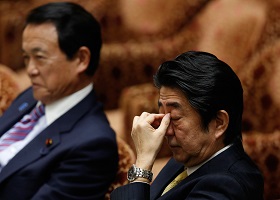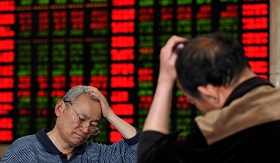On the morning of April 15, 2015, the website of the U.S. Department of the Treasury published its Major Foreign Holders of Treasury Securities indicator for February, and there was a new name at the top of the list. After six years, Japan has regained its leading position as the U.S. government’s primary borrower. The country has $1,224.4 billion, followed by China with $1,223.7 billion. Together, they make up 39.7 per cent of the total $6,162.8 billion held by foreign countries in U.S. treasury securities. Japan’s lead over China is some $700 million. However, this amount is negligible when the size of the two countries’ investments into the United States’ national debt is taken into account.
On the morning of April 15, 2015, the website of the U.S. Department of the Treasury published its Major Foreign Holders of Treasury Securities indicator for February, and there was a new name at the top of the list. After six years, Japan has regained its leading position as the U.S. government’s primary borrower. The country has $1,224.4 billion, followed by China with $1,223.7 billion. Together, they make up 39.7 per cent of the total $6,162.8 billion held by foreign countries in U.S. treasury securities. Japan’s lead over China is some $700 million. However, this amount is negligible when the size of the two countries’ investments into the United States’ national debt is taken into account.
Yet, as they say: it may be a little, but it’s nothing to sneeze at. The Japanese press, latching onto this news, have drawn attention to the two main reasons for this “balance of powers”: 1) the policy of quantitative easing in Japan; and 2) changes in China’s foreign exchange policy. Both factors are essentially “technical”, rather than fundamental. As such, they answer the main question regarding this reshuffle of leading borrowers: Is Japan regaining lost ground in the global economy?
At the same time, a full and complete answer to this question is impossible without projecting the situation onto the macroeconomic situation in both countries. The policy of quantitative easing in Japan is one of three areas of “Abenomics”, the name given to the economic policies advocated by Prime Minister Shinzo Abe following the return of the Liberal Democratic Party to power in December 2012.
The large-scale purchase of foreign public bonds by the Bank of Japan is a part of the policy to increase the monetary stock, or monetize the economy. This has helped to fill the market with “working” money, make bank loans more readily available and turn deflation into moderate inflation.
The yen “fell” 30 per cent during this time, making Japanese goods significantly cheaper, both outside and inside the country. Japan is currently enjoying an unprecedented influx of foreign tourists. Last year, 2.4 million people visited the country from China alone.
The average index of shares on the Tokyo Stock Exchange has doubled in the two years and four months since Abe took office. Nevertheless, one has to wonder how stable this artificial cycle of quantitative easing is: monetary stock; shares; loans; injecting money into production; business income; rising wages; rising consumption. What is the best way to deal with inflation that eats away at pay rises and leads to a decrease in real wages? What should Japan do with its own national debt, which is approaching the 1,200 trillion yen mark and makes up 230 per cent of the country’s GDP? Unlike Greece, Japan’s debt is mostly domestic and does not “bite” as much. But this question, like many others, remains unanswered.
As for Japan returning to the position of the global economy’s “second superpower”, this is both unlikely and unnecessary. At one time, Japan would not have wanted to cede this position at any cost, especially to China. But this is in the past. The main thing now is to ensure sustainable growth in an increasingly volatile global market and growing geopolitical risks.
China has its own problems, and dropping to second place in the list of U.S. creditors is not even an issue. The drop-off in the Chinese economy is evident, with imports for March falling 12 per cent year-on-year, and exports falling 15 per cent. The rate of production growth has also slowed down. Chinese money has started to flow abroad in search of better investment conditions. To alleviate this, the Bank of China has started selling U.S. bonds and purchasing its own currency. In the year from February 2014, Beijing sold off almost $50 billion of its foreign reserves.
Is China surrendering its positions? This is debatable, although so far the evidence suggests only a slowdown in growth, which is still rapid. The driving force behind the global economy is starting to “falter” slightly in some areas, but it is moving full steam ahead nevertheless. Now both the domestic Chinese market and Chinese money abroad are starting to “work”. Taking into account transactions with third parties, Chinese foreign investments totalled $140 billion, against $119.6 billion invested domestically. And that’s just the beginning. As of the end of 2014, Chinese gold reserves amounted to $3.89 trillion (link in Chinese). This is three times the $1.25 trillion that Japan had at the beginning of April 2015.
Construction will soon start on the Asian Infrastructure Investment Bank (AIIB) skyscraper in Beijing’s financial district, not far from the offices of the Communist Party of China. England’s bid to join the bank, along with the willingness of France, Germany and Italy to follow suit, represents a triumph of Chinese money over any geopolitical concerns that other countries may have. The Financial Times openly stated that rebuffing the AIIB would be “folly”, hinting at Japan and the United States. This, however, is not yet prevailing opinion in Japan, which is much closer to China.






